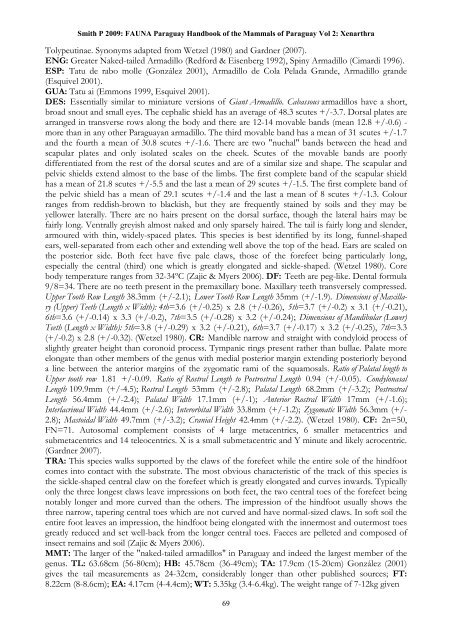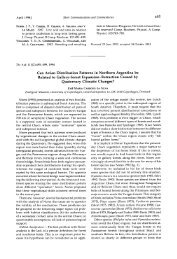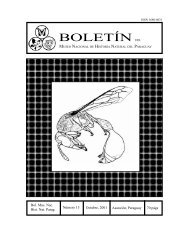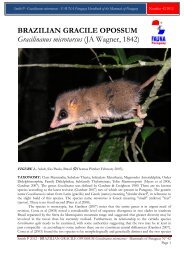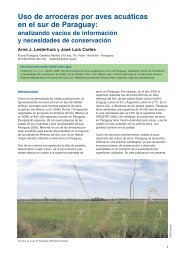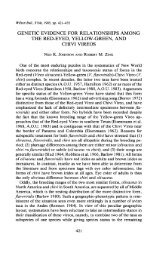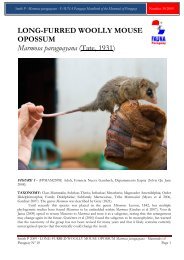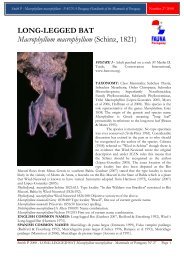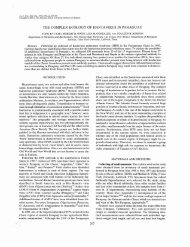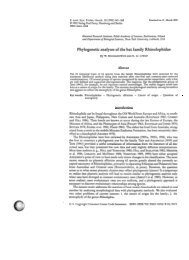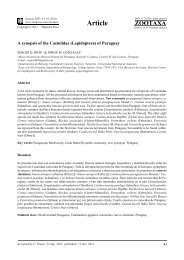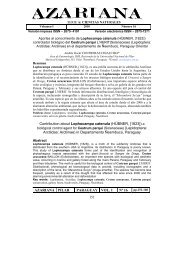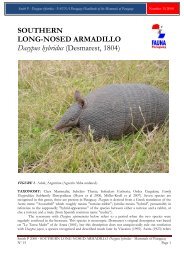hbk mammals vol 2 - FAUNA Paraguay
hbk mammals vol 2 - FAUNA Paraguay
hbk mammals vol 2 - FAUNA Paraguay
Create successful ePaper yourself
Turn your PDF publications into a flip-book with our unique Google optimized e-Paper software.
Smith P 2009: <strong>FAUNA</strong> <strong>Paraguay</strong> Handbook of the Mammals of <strong>Paraguay</strong> Vol 2: Xenarthra<br />
Tolypeutinae. Synonyms adapted from Wetzel (1980) and Gardner (2007).<br />
ENG: Greater Naked-tailed Armadillo (Redford & Eisenberg 1992), Spiny Armadillo (Cimardi 1996).<br />
ESP: Tatu de rabo molle (González 2001), Armadillo de Cola Pelada Grande, Armadillo grande<br />
(Esquivel 2001).<br />
GUA: Tatu ai (Emmons 1999, Esquivel 2001).<br />
DES: Essentially similar to miniature versions of Giant Armadillo. Cabassous armadillos have a short,<br />
broad snout and small eyes. The cephalic shield has an average of 48.3 scutes +/-3.7. Dorsal plates are<br />
arranged in transverse rows along the body and there are 12-14 movable bands (mean 12.8 +/-0.6) -<br />
more than in any other <strong>Paraguay</strong>an armadillo. The third movable band has a mean of 31 scutes +/-1.7<br />
and the fourth a mean of 30.8 scutes +/-1.6. There are two "nuchal" bands between the head and<br />
scapular plates and only isolated scales on the cheek. Scutes of the movable bands are poorly<br />
differentiated from the rest of the dorsal scutes and are of a similar size and shape. The scapular and<br />
pelvic shields extend almost to the base of the limbs. The first complete band of the scapular shield<br />
has a mean of 21.8 scutes +/-5.5 and the last a mean of 29 scutes +/-1.5. The first complete band of<br />
the pelvic shield has a mean of 29.1 scutes +/-1.4 and the last a mean of 8 scutes +/-1.3. Colour<br />
ranges from reddish-brown to blackish, but they are frequently stained by soils and they may be<br />
yellower laterally. There are no hairs present on the dorsal surface, though the lateral hairs may be<br />
fairly long. Ventrally greyish almost naked and only sparsely haired. The tail is fairly long and slender,<br />
armoured with thin, widely-spaced plates. This species is best identified by its long, funnel-shaped<br />
ears, well-separated from each other and extending well above the top of the head. Ears are scaled on<br />
the posterior side. Both feet have five pale claws, those of the forefeet being particularly long,<br />
especially the central (third) one which is greatly elongated and sickle-shaped. (Wetzel 1980). Core<br />
body temperature ranges from 32-34ºC (Zajic & Myers 2006). DF: Teeth are peg-like. Dental formula<br />
9/8=34. There are no teeth present in the premaxillary bone. Maxillary teeth transversely compressed.<br />
Upper Tooth Row Length 38.3mm (+/-2.1); Lower Tooth Row Length 35mm (+/-1.9). Dimensions of Maxillary<br />
(Upper) Teeth (Length x Width): 4th=3.6 (+/-0.25) x 2.8 (+/-0.26), 5th=3.7 (+/-0.2) x 3.1 (+/-0.21),<br />
6th=3.6 (+/-0.14) x 3.3 (+/-0.2), 7th=3.5 (+/-0.28) x 3.2 (+/-0.24); Dimensions of Mandibular (Lower)<br />
Teeth (Length x Width): 5th=3.8 (+/-0.29) x 3.2 (+/-0.21), 6th=3.7 (+/-0.17) x 3.2 (+/-0.25), 7th=3.3<br />
(+/-0.2) x 2.8 (+/-0.32). (Wetzel 1980). CR: Mandible narrow and straight with condyloid process of<br />
slightly greater height than coronoid process. Tympanic rings present rather than bullae. Palate more<br />
elongate than other members of the genus with medial posterior margin extending posteriorly beyond<br />
a line between the anterior margins of the zygomatic rami of the squamosals. Ratio of Palatal length to<br />
Upper tooth row 1.81 +/-0.09. Ratio of Rostral Length to Postrostral Length 0.94 (+/-0.05). Condylonasal<br />
Length 109.9mm (+/-4.5); Rostral Length 53mm (+/-2.8); Palatal Length 68.2mm (+/-3.2); Postrostral<br />
Length 56.4mm (+/-2.4); Palatal Width 17.1mm (+/-1); Anterior Rostral Width 17mm (+/-1.6);<br />
Interlacrimal Width 44.4mm (+/-2.6); Interorbital Width 33.8mm (+/-1.2); Zygomatic Width 56.3mm (+/-<br />
2.8); Mastoidal Width 49.7mm (+/-3.2); Cranial Height 42.4mm (+/-2.2). (Wetzel 1980). CF: 2n=50,<br />
FN=71. Autosomal complement consists of 4 large metacentrics, 6 smaller metacentrics and<br />
submetacentrics and 14 teleocentrics. X is a small submetacentric and Y minute and likely acrocentric.<br />
(Gardner 2007).<br />
TRA: This species walks supported by the claws of the forefeet while the entire sole of the hindfoot<br />
comes into contact with the substrate. The most obvious characteristic of the track of this species is<br />
the sickle-shaped central claw on the forefeet which is greatly elongated and curves inwards. Typically<br />
only the three longest claws leave impressions on both feet, the two central toes of the forefeet being<br />
notably longer and more curved than the others. The impression of the hindfoot usually shows the<br />
three narrow, tapering central toes which are not curved and have normal-sized claws. In soft soil the<br />
entire foot leaves an impression, the hindfoot being elongated with the innermost and outermost toes<br />
greatly reduced and set well-back from the longer central toes. Faeces are pelleted and composed of<br />
insect remains and soil (Zajic & Myers 2006).<br />
MMT: The larger of the "naked-tailed armadillos" in <strong>Paraguay</strong> and indeed the largest member of the<br />
genus. TL: 63.68cm (56-80cm); HB: 45.78cm (36-49cm); TA: 17.9cm (15-20cm) González (2001)<br />
gives the tail measurements as 24-32cm, considerably longer than other published sources; FT:<br />
8.22cm (8-8.6cm); EA: 4.17cm (4-4.4cm); WT: 5.35kg (3.4-6.4kg). The weight range of 7-12kg given<br />
69


